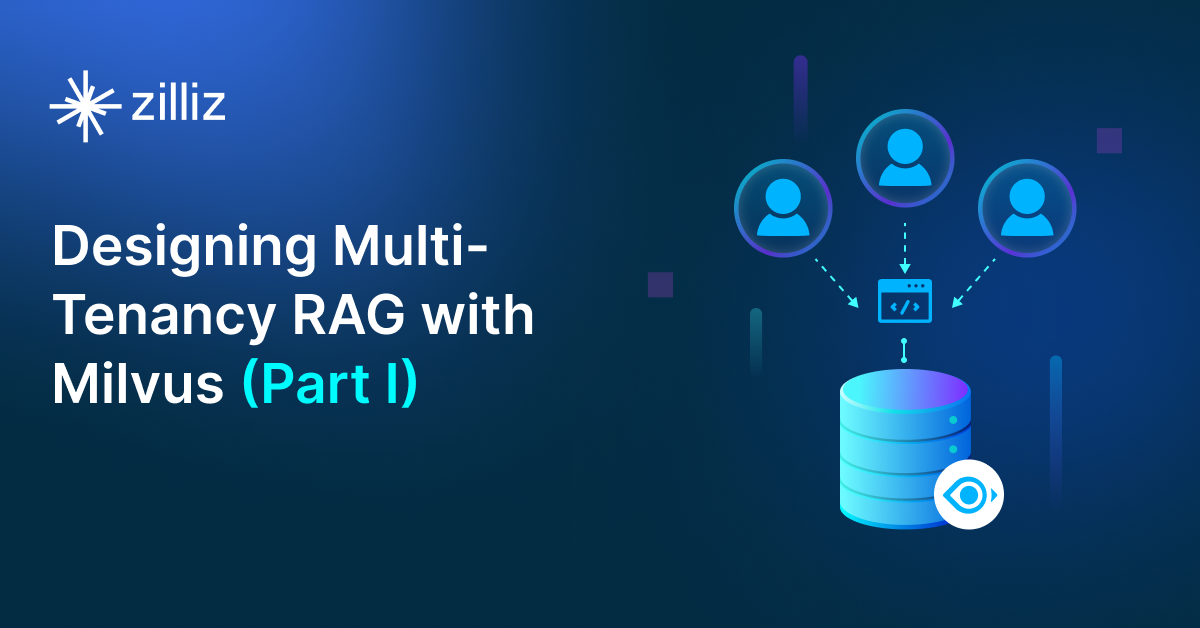Build RAG Chatbot with LangChain, Milvus, Groq Qwen2.5 32B Instruct, and NVIDIA llama-3.2-nv-embedqa-1b-v2
Introduction to RAG
Retrieval-Augmented Generation (RAG) is a game-changer for GenAI applications, especially in conversational AI. It combines the power of pre-trained large language models (LLMs) like OpenAI’s GPT with external knowledge sources stored in vector databases such as Milvus and Zilliz Cloud, allowing for more accurate, contextually relevant, and up-to-date response generation. A RAG pipeline usually consists of four basic components: a vector database, an embedding model, an LLM, and a framework.
Key Components We'll Use for This RAG Chatbot
This tutorial shows you how to build a simple RAG chatbot in Python using the following components:
- LangChain: An open-source framework that helps you orchestrate the interaction between LLMs, vector stores, embedding models, etc, making it easier to integrate a RAG pipeline.
- Milvus: An open-source vector database optimized to store, index, and search large-scale vector embeddings efficiently, perfect for use cases like RAG, semantic search, and recommender systems. If you hate to manage your own infrastructure, we recommend using Zilliz Cloud, which is a fully managed vector database service built on Milvus and offers a free tier supporting up to 1 million vectors.
- Groq Qwen2.5 32B Instruct: Groq Qwen2.5 is a large-scale AI language model designed for instruction-following tasks. With 32 billion parameters, it excels in generating coherent, contextually relevant responses and understanding complex queries. Ideal for applications in customer service, content creation, and educational tools, it enhances user interactions through its robust and adaptable capabilities.
- NVIDIA llama-3.2-nv-embedqa-1b-v2: This AI model is designed for advanced question-answering tasks, leveraging NVIDIA's LLaMA architecture. It excels in embedding-based question retrieval and provides high accuracy in understanding context. Ideal for knowledge-intensive applications, it enhances customer support, educational tools, and research assistance.
By the end of this tutorial, you’ll have a functional chatbot capable of answering questions based on a custom knowledge base.
Note: Since we may use proprietary models in our tutorials, make sure you have the required API key beforehand.
Step 1: Install and Set Up LangChain
%pip install --quiet --upgrade langchain-text-splitters langchain-community langgraph
Step 2: Install and Set Up Groq Qwen2.5 32B Instruct
pip install -qU "langchain[groq]"
import getpass
import os
if not os.environ.get("GROQ_API_KEY"):
os.environ["GROQ_API_KEY"] = getpass.getpass("Enter API key for Groq: ")
from langchain.chat_models import init_chat_model
llm = init_chat_model("qwen-2.5-32b", model_provider="groq")
Step 3: Install and Set Up NVIDIA llama-3.2-nv-embedqa-1b-v2
pip install -qU langchain-nvidia-ai-endpoints
import getpass
import os
if not os.environ.get("NVIDIA_API_KEY"):
os.environ["NVIDIA_API_KEY"] = getpass.getpass("Enter API key for NVIDIA: ")
from langchain_nvidia_ai_endpoints import NVIDIAEmbeddings
embeddings = NVIDIAEmbeddings(model="nvidia/llama-3.2-nv-embedqa-1b-v2")
Step 4: Install and Set Up Milvus
pip install -qU langchain-milvus
from langchain_milvus import Milvus
vector_store = Milvus(embedding_function=embeddings)
Step 5: Build a RAG Chatbot
Now that you’ve set up all components, let’s start to build a simple chatbot. We’ll use the Milvus introduction doc as a private knowledge base. You can replace it with your own dataset to customize your RAG chatbot.
import bs4
from langchain import hub
from langchain_community.document_loaders import WebBaseLoader
from langchain_core.documents import Document
from langchain_text_splitters import RecursiveCharacterTextSplitter
from langgraph.graph import START, StateGraph
from typing_extensions import List, TypedDict
# Load and chunk contents of the blog
loader = WebBaseLoader(
web_paths=("https://milvus.io/docs/overview.md",),
bs_kwargs=dict(
parse_only=bs4.SoupStrainer(
class_=("doc-style doc-post-content")
)
),
)
docs = loader.load()
text_splitter = RecursiveCharacterTextSplitter(chunk_size=1000, chunk_overlap=200)
all_splits = text_splitter.split_documents(docs)
# Index chunks
_ = vector_store.add_documents(documents=all_splits)
# Define prompt for question-answering
prompt = hub.pull("rlm/rag-prompt")
# Define state for application
class State(TypedDict):
question: str
context: List[Document]
answer: str
# Define application steps
def retrieve(state: State):
retrieved_docs = vector_store.similarity_search(state["question"])
return {"context": retrieved_docs}
def generate(state: State):
docs_content = "\n\n".join(doc.page_content for doc in state["context"])
messages = prompt.invoke({"question": state["question"], "context": docs_content})
response = llm.invoke(messages)
return {"answer": response.content}
# Compile application and test
graph_builder = StateGraph(State).add_sequence([retrieve, generate])
graph_builder.add_edge(START, "retrieve")
graph = graph_builder.compile()
Test the Chatbot
Yeah! You've built your own chatbot. Let's ask the chatbot a question.
response = graph.invoke({"question": "What data types does Milvus support?"})
print(response["answer"])
Example Output
Milvus supports various data types including sparse vectors, binary vectors, JSON, and arrays. Additionally, it handles common numerical and character types, making it versatile for different data modeling needs. This allows users to manage unstructured or multi-modal data efficiently.
Optimization Tips
As you build your RAG system, optimization is key to ensuring peak performance and efficiency. While setting up the components is an essential first step, fine-tuning each one will help you create a solution that works even better and scales seamlessly. In this section, we’ll share some practical tips for optimizing all these components, giving you the edge to build smarter, faster, and more responsive RAG applications.
LangChain optimization tips
To optimize LangChain, focus on minimizing redundant operations in your workflow by structuring your chains and agents efficiently. Use caching to avoid repeated computations, speeding up your system, and experiment with modular design to ensure that components like models or databases can be easily swapped out. This will provide both flexibility and efficiency, allowing you to quickly scale your system without unnecessary delays or complications.
Milvus optimization tips
Milvus serves as a highly efficient vector database, critical for retrieval tasks in a RAG system. To optimize its performance, ensure that indexes are properly built to balance speed and accuracy; consider utilizing HNSW (Hierarchical Navigable Small World) for efficient nearest neighbor search where response time is crucial. Partitioning data based on usage patterns can enhance query performance and reduce load times, enabling better scalability. Regularly monitor and adjust cache settings based on query frequency to avoid latency during data retrieval. Employ batch processing for vector insertions, which can minimize database lock contention and enhance overall throughput. Additionally, fine-tune the model parameters by experimenting with the dimensionality of the vectors; higher dimensions can improve retrieval accuracy but may increase search time, necessitating a balance tailored to your specific use case and hardware infrastructure.
Groq Qwen2.5 32B Instruct optimization tips
To optimize the Groq Qwen2.5 32B Instruct model in a Retrieval-Augmented Generation (RAG) setup, consider implementing mixed precision training to reduce memory usage and enhance throughput. Fine-tune hyperparameters such as learning rate and batch size based on your dataset to improve performance. Utilize efficient indexing methods for retrieval components to speed up query responses. Additionally, cache frequent queries and responses to minimize redundant computations. Regularly assess model performance on validation data to identify any degradation over time, allowing for timely retraining or adjustments. Lastly, leverage data augmentation techniques to enrich your training dataset, which can help the model generalize better across unseen queries.
NVIDIA llama-3.2-nv-embedqa-1b-v2 optimization tips
To optimize the performance of the NVIDIA llama-3.2-nv-embedqa-1b-v2 in a Retrieval-Augmented Generation setup, consider employing mixed precision training to enhance computational efficiency while maintaining model accuracy. Utilize efficient indexing and retrieval methods, such as FAISS, to quickly access relevant documents, minimizing response time. Tune the hyperparameters, especially the learning rate and batch size, based on validation metrics to improve convergence speed. Implement caching strategies to store frequently accessed data and results for faster retrieval. Regularly profile the model to identify bottlenecks and make necessary adjustments. Finally, leverage NVIDIA’s TensorRT for optimized inference, ensuring that your setup benefits from accelerated performance on compatible hardware.
By implementing these tips across your components, you'll be able to enhance the performance and functionality of your RAG system, ensuring it’s optimized for both speed and accuracy. Keep testing, iterating, and refining your setup to stay ahead in the ever-evolving world of AI development.
RAG Cost Calculator: A Free Tool to Calculate Your Cost in Seconds
Estimating the cost of a Retrieval-Augmented Generation (RAG) pipeline involves analyzing expenses across vector storage, compute resources, and API usage. Key cost drivers include vector database queries, embedding generation, and LLM inference.
RAG Cost Calculator is a free tool that quickly estimates the cost of building a RAG pipeline, including chunking, embedding, vector storage/search, and LLM generation. It also helps you identify cost-saving opportunities and achieve up to 10x cost reduction on vector databases with the serverless option.
 Calculate your RAG cost
Calculate your RAG cost
What Have You Learned?
By diving into this tutorial, you’ve unlocked the magic of building a modern RAG system from the ground up! You learned how LangChain acts as the glue, orchestrating workflows to seamlessly connect your components. By integrating Milvus as your vector database, you now understand how to store and retrieve embeddings at lightning speed, ensuring your system can handle massive datasets without breaking a sweat. The NVIDIA llama-3.2-nv-embedqa-1b-v2 embedding model became your secret weapon for transforming text into rich numerical representations, while Groq’s blazing-fast Qwen2.5 32B Instruct model showed off its chops as the LLM powerhouse, generating human-like responses that feel both accurate and natural. Together, these pieces formed a dynamic pipeline: ingesting data, embedding it, storing it intelligently, and retrieving context-aware answers—all while you fine-tuned performance with pro tips like optimizing chunk sizes and indexing strategies. Oh, and let’s not forget the free RAG cost calculator you explored, a game-changer for balancing speed, accuracy, and budget in real-world projects!
Now you’re equipped to build smarter, faster, and more efficient AI applications. Whether you’re crafting chatbots, enhancing search engines, or revolutionizing knowledge management, the tools you’ve mastered here are your launchpad. The best part? This is just the beginning. Experiment with different models, tweak retrieval parameters, or add layers like reranking to push your system further. The world of RAG is evolving rapidly, and you’re already at the forefront. So fire up your IDE, embrace the tinkering, and let your creativity run wild—your next breakthrough is waiting to be built. Go show the world what you can do! 🚀
Further Resources
🌟 In addition to this RAG tutorial, unleash your full potential with these incredible resources to level up your RAG skills.
- How to Build a Multimodal RAG | Documentation
- How to Enhance the Performance of Your RAG Pipeline
- Graph RAG with Milvus | Documentation
- How to Evaluate RAG Applications - Zilliz Learn
- Generative AI Resource Hub | Zilliz
We'd Love to Hear What You Think!
We’d love to hear your thoughts! 🌟 Leave your questions or comments below or join our vibrant Milvus Discord community to share your experiences, ask questions, or connect with thousands of AI enthusiasts. Your journey matters to us!
If you like this tutorial, show your support by giving our Milvus GitHub repo a star ⭐—it means the world to us and inspires us to keep creating! 💖
- Introduction to RAG
- Key Components We'll Use for This RAG Chatbot
- Step 1: Install and Set Up LangChain
- Step 2: Install and Set Up Groq Qwen2.5 32B Instruct
- Step 3: Install and Set Up NVIDIA llama-3.2-nv-embedqa-1b-v2
- Step 4: Install and Set Up Milvus
- Step 5: Build a RAG Chatbot
- Optimization Tips
- RAG Cost Calculator: A Free Tool to Calculate Your Cost in Seconds
- What Have You Learned?
- Further Resources
- We'd Love to Hear What You Think!
Content
Vector Database at Scale
Zilliz Cloud is a fully-managed vector database built for scale, perfect for your RAG apps.
Try Zilliz Cloud for Free


